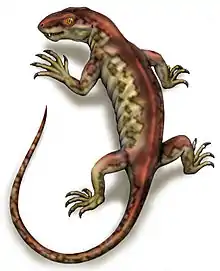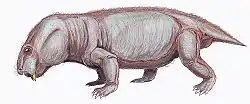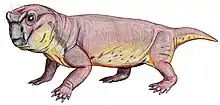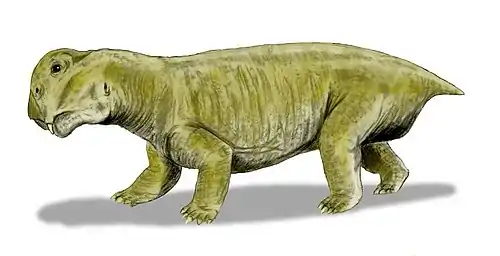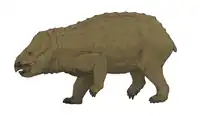Placerias
Placerias (meaning 'broad body')[2] is an extinct genus of dicynodonts that lived during the Carnian to the Norian age of the Triassic Period (230–220 million years ago). Placerias belongs to a group of dicynodonts called Kannemeyeriiformes, which was the last known group of dicynodonts before the taxon became extinct at the end of the Triassic.
| Placerias | |
|---|---|
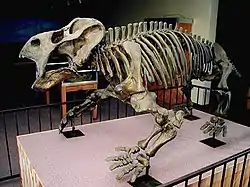 | |
| Skeleton | |
| Scientific classification | |
| Domain: | Eukaryota |
| Kingdom: | Animalia |
| Phylum: | Chordata |
| Clade: | Synapsida |
| Clade: | Therapsida |
| Suborder: | †Anomodontia |
| Clade: | †Dicynodontia |
| Family: | †Stahleckeriidae |
| Subfamily: | †Placeriinae |
| Genus: | †Placerias Lucas, 1904 |
| Species: | †P. hesternus |
| Binomial name | |
| †Placerias hesternus Lucas, 1904 | |
Description
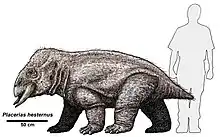
Placerias was one of the largest herbivores in the Late Triassic, with large skull measuring 68 centimetres (26.8 in) long[3] and weighing up to 1 metric ton (1.1 short tons)[4] with a powerful neck, strong legs, and a barrel-shaped body. There are possible ecological and evolutionary parallels with the modern hippopotamus, spending much of its time during the wet season wallowing in the water, chewing at bankside vegetation. Remaining in the water would also have given Placerias some protection against land-based predators such as Postosuchus. Placerias used its beak to slice through thick branches and roots with two short tusks that could be used for defence and for intra-specific display. Placerias was closely related to Ischigualastia and similar in appearance.
Discovery
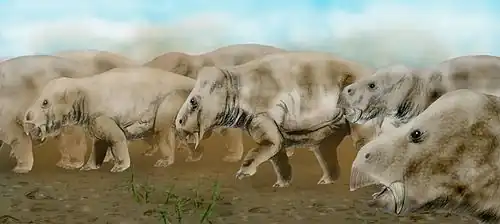
Fossils of forty Placerias were found near St. Johns, southeast of the Petrified Forest in the Chinle Formation of Arizona. This site has become known as the 'Placerias Quarry' and was discovered in 1930, by Charles Camp and Samuel Welles, of the University of California, Berkeley. Sedimentological features of the site indicate a low-energy depositional environment, possibly flood-plain or overbank. Bones are associated mostly with mudstones and a layer that contains numerous carbonate nodules. It is also known from the Pekin Formation of North Carolina.[5]
Placerias was originally considered the last of the dicynodonts until fossil finds from Queensland were reported in 2003 to have revealed that the dicynodonts survived until the Early Cretaceous.[6] Agnolin et al. (2010) called for a reconsideration of that Australian specimen, noting its similarity to baurusuchian crocodyliforms such as Baurusuchus pachecoi.[7] The Cretaceous dicynodont specimen was eventually discovered to belong to a specimen of Diprotodon instead.[8] The giant dicynodont Lisowicia also survived into the late Triassic.[9]
See also
References
- Kent, Dennis V.; Olsen, Paul E.; Lepre, Christopher; Rasmussen, Cornelia; Mundil, Roland; Gehrels, George E.; Giesler, Dominique; Irmis, Randall B.; Geissman, John W.; Parker, William G. (October 16, 2019). "Magnetochronology of the Entire Chinle Formation (Norian Age) in a Scientific Drill Core From Petrified Forest National Park (Arizona, USA) and Implications for Regional and Global Correlations in the Late Triassic" (PDF). Geochemistry, Geophysics, Geosystems. American Geophysical Union. 20 (11): 4654–4664. Bibcode:2019GGG....20.4654K. doi:10.1029/2019GC008474. S2CID 207980627.
- Paleofile. "Page on Placerias". Retrieved 20 February 2010.
- Green, Jeremy; Schneider, Vince; Schweitzer, Mary; Clarke, Julia (2005-09-07). "NEW EVIDENCE FOR NON-PLACERIAS DICYNODONTS IN THE LATE TRIASSIC (CARNIAN-NORIAN) OF NORTH AMERICA". Journal of Vertebrate Paleontology. 25: 65A–66A.
- Fiorillo, Anthony R.; Padian, Kevin; Musikasinthorn, Chayanin (2000). "Taphonomy and Depositional Setting of the Placerias Quarry (Chinle Formation: Late Triassic, Arizona)". PALAIOS. 15 (5): 373–386. doi:10.2307/3515510. ISSN 0883-1351. JSTOR 3515510.
- "Fossilworks: Placerias hesternus". fossilworks.org. Retrieved 17 December 2021.
- Thulborn, T.; Turner, S. (2003). "The last dicynodont: an Australian Cretaceous relic". Proceedings of the Royal Society of London B. 270 (1518): 985–993. doi:10.1098/rspb.2002.2296. PMC 1691326. PMID 12803915.
- Agnolin, F. L.; Ezcurra, M. D.; Pais, D. F.; Salisbury, S. W. (2010). "A reappraisal of the Cretaceous non-avian dinosaur faunas from Australia and New Zealand: Evidence for their Gondwanan affinities". Journal of Systematic Palaeontology. 8 (2): 257–300. doi:10.1080/14772011003594870. S2CID 130568551.
- Knutsen, Espen M.; Oerlemans, Emma (January 2020). "The last dicynodont? Re-assessing the taxonomic and temporal relationships of a contentious Australian fossil". Gondwana Research. 77: 184–203. Bibcode:2020GondR..77..184K. doi:10.1016/j.gr.2019.07.011. S2CID 202908716.
- Racki, Grzegorz; Lucas, Spencer G. (2020-04-20). "Timing of dicynodont extinction in light of an unusual Late Triassic Polish fauna and Cuvier's approach to extinction". Historical Biology. 32 (4): 452–461. doi:10.1080/08912963.2018.1499734. ISSN 0891-2963. S2CID 91926999.
